Xi Victoria Lin
DRAMA: Diverse Augmentation from Large Language Models to Smaller Dense Retrievers
Feb 25, 2025Abstract:Large language models (LLMs) have demonstrated strong effectiveness and robustness while fine-tuned as dense retrievers. However, their large parameter size brings significant inference time computational challenges, including high encoding costs for large-scale corpora and increased query latency, limiting their practical deployment. While smaller retrievers offer better efficiency, they often fail to generalize effectively with limited supervised fine-tuning data. In this work, we introduce DRAMA, a training framework that leverages LLMs to train smaller generalizable dense retrievers. In particular, we adopt pruned LLMs as the backbone and train on diverse LLM-augmented data in a single-stage contrastive learning setup. Experiments show that DRAMA offers better multilingual and long-context capabilities than traditional encoder-based retrievers, and achieves strong performance across multiple tasks and languages. These highlight the potential of connecting the training of smaller retrievers with the growing advancements in LLMs, bridging the gap between efficiency and generalization.
SelfCite: Self-Supervised Alignment for Context Attribution in Large Language Models
Feb 13, 2025



Abstract:We introduce SelfCite, a novel self-supervised approach that aligns LLMs to generate high-quality, fine-grained, sentence-level citations for the statements in their generated responses. Instead of only relying on costly and labor-intensive annotations, SelfCite leverages a reward signal provided by the LLM itself through context ablation: If a citation is necessary, removing the cited text from the context should prevent the same response; if sufficient, retaining the cited text alone should preserve the same response. This reward can guide the inference-time best-of-N sampling strategy to improve citation quality significantly, as well as be used in preference optimization to directly fine-tune the models for generating better citations. The effectiveness of SelfCite is demonstrated by increasing citation F1 up to 5.3 points on the LongBench-Cite benchmark across five long-form question answering tasks.
LMFusion: Adapting Pretrained Language Models for Multimodal Generation
Dec 26, 2024



Abstract:We present LMFusion, a framework for empowering pretrained text-only large language models (LLMs) with multimodal generative capabilities, enabling them to understand and generate both text and images in arbitrary sequences. LMFusion leverages existing Llama-3's weights for processing texts autoregressively while introducing additional and parallel transformer modules for processing images with diffusion. During training, the data from each modality is routed to its dedicated modules: modality-specific feedforward layers, query-key-value projections, and normalization layers process each modality independently, while the shared self-attention layers allow interactions across text and image features. By freezing the text-specific modules and only training the image-specific modules, LMFusion preserves the language capabilities of text-only LLMs while developing strong visual understanding and generation abilities. Compared to methods that pretrain multimodal generative models from scratch, our experiments demonstrate that, LMFusion improves image understanding by 20% and image generation by 3.6% using only 50% of the FLOPs while maintaining Llama-3's language capabilities. We also demonstrate that this framework can adapt existing vision-language models with multimodal generation ability. Overall, this framework not only leverages existing computational investments in text-only LLMs but also enables the parallel development of language and vision capabilities, presenting a promising direction for efficient multimodal model development.
LlamaFusion: Adapting Pretrained Language Models for Multimodal Generation
Dec 19, 2024



Abstract:We present LlamaFusion, a framework for empowering pretrained text-only large language models (LLMs) with multimodal generative capabilities, enabling them to understand and generate both text and images in arbitrary sequences. LlamaFusion leverages existing Llama-3's weights for processing texts autoregressively while introducing additional and parallel transformer modules for processing images with diffusion. During training, the data from each modality is routed to its dedicated modules: modality-specific feedforward layers, query-key-value projections, and normalization layers process each modality independently, while the shared self-attention layers allow interactions across text and image features. By freezing the text-specific modules and only training the image-specific modules, LlamaFusion preserves the language capabilities of text-only LLMs while developing strong visual understanding and generation abilities. Compared to methods that pretrain multimodal generative models from scratch, our experiments demonstrate that, LlamaFusion improves image understanding by 20% and image generation by 3.6% using only 50% of the FLOPs while maintaining Llama-3's language capabilities. We also demonstrate that this framework can adapt existing vision-language models with multimodal generation ability. Overall, this framework not only leverages existing computational investments in text-only LLMs but also enables the parallel development of language and vision capabilities, presenting a promising direction for efficient multimodal model development.
Mixture-of-Transformers: A Sparse and Scalable Architecture for Multi-Modal Foundation Models
Nov 07, 2024

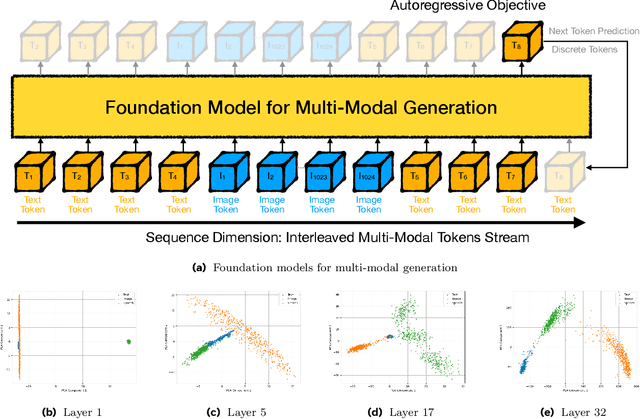

Abstract:The development of large language models (LLMs) has expanded to multi-modal systems capable of processing text, images, and speech within a unified framework. Training these models demands significantly larger datasets and computational resources compared to text-only LLMs. To address the scaling challenges, we introduce Mixture-of-Transformers (MoT), a sparse multi-modal transformer architecture that significantly reduces pretraining computational costs. MoT decouples non-embedding parameters of the model by modality -- including feed-forward networks, attention matrices, and layer normalization -- enabling modality-specific processing with global self-attention over the full input sequence. We evaluate MoT across multiple settings and model scales. In the Chameleon 7B setting (autoregressive text-and-image generation), MoT matches the dense baseline's performance using only 55.8\% of the FLOPs. When extended to include speech, MoT reaches speech performance comparable to the dense baseline with only 37.2\% of the FLOPs. In the Transfusion setting, where text and image are trained with different objectives, a 7B MoT model matches the image modality performance of the dense baseline with one third of the FLOPs, and a 760M MoT model outperforms a 1.4B dense baseline across key image generation metrics. System profiling further highlights MoT's practical benefits, achieving dense baseline image quality in 47.2\% of the wall-clock time and text quality in 75.6\% of the wall-clock time (measured on AWS p4de.24xlarge instances with NVIDIA A100 GPUs).
MoMa: Efficient Early-Fusion Pre-training with Mixture of Modality-Aware Experts
Jul 31, 2024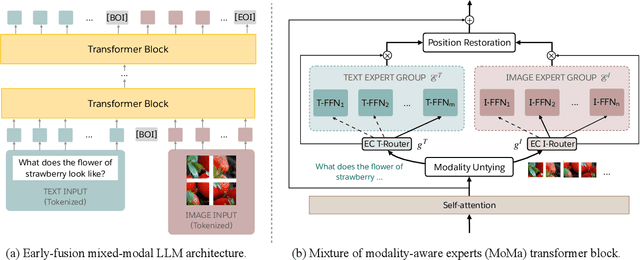

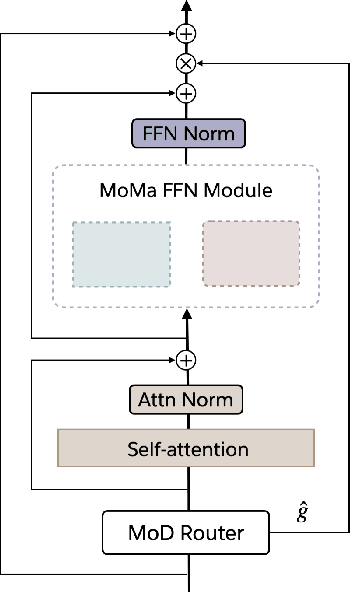
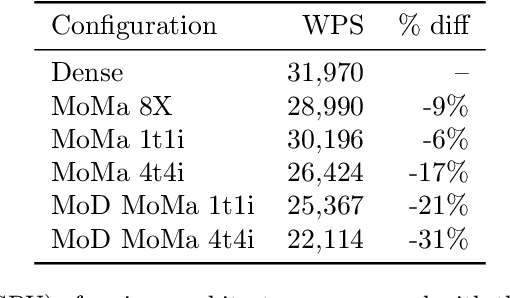
Abstract:We introduce MoMa, a novel modality-aware mixture-of-experts (MoE) architecture designed for pre-training mixed-modal, early-fusion language models. MoMa processes images and text in arbitrary sequences by dividing expert modules into modality-specific groups. These groups exclusively process designated tokens while employing learned routing within each group to maintain semantically informed adaptivity. Our empirical results reveal substantial pre-training efficiency gains through this modality-specific parameter allocation. Under a 1-trillion-token training budget, the MoMa 1.4B model, featuring 4 text experts and 4 image experts, achieves impressive FLOPs savings: 3.7x overall, with 2.6x for text and 5.2x for image processing compared to a compute-equivalent dense baseline, measured by pre-training loss. This outperforms the standard expert-choice MoE with 8 mixed-modal experts, which achieves 3x overall FLOPs savings (3x for text, 2.8x for image). Combining MoMa with mixture-of-depths (MoD) further improves pre-training FLOPs savings to 4.2x overall (text: 3.4x, image: 5.3x), although this combination hurts performance in causal inference due to increased sensitivity to router accuracy. These results demonstrate MoMa's potential to significantly advance the efficiency of mixed-modal, early-fusion language model pre-training, paving the way for more resource-efficient and capable multimodal AI systems.
Nearest Neighbor Speculative Decoding for LLM Generation and Attribution
May 29, 2024



Abstract:Large language models (LLMs) often hallucinate and lack the ability to provide attribution for their generations. Semi-parametric LMs, such as kNN-LM, approach these limitations by refining the output of an LM for a given prompt using its nearest neighbor matches in a non-parametric data store. However, these models often exhibit slow inference speeds and produce non-fluent texts. In this paper, we introduce Nearest Neighbor Speculative Decoding (NEST), a novel semi-parametric language modeling approach that is capable of incorporating real-world text spans of arbitrary length into the LM generations and providing attribution to their sources. NEST performs token-level retrieval at each inference step to compute a semi-parametric mixture distribution and identify promising span continuations in a corpus. It then uses an approximate speculative decoding procedure that accepts a prefix of the retrieved span or generates a new token. NEST significantly enhances the generation quality and attribution rate of the base LM across a variety of knowledge-intensive tasks, surpassing the conventional kNN-LM method and performing competitively with in-context retrieval augmentation. In addition, NEST substantially improves the generation speed, achieving a 1.8x speedup in inference time when applied to Llama-2-Chat 70B.
Branch-Train-MiX: Mixing Expert LLMs into a Mixture-of-Experts LLM
Mar 12, 2024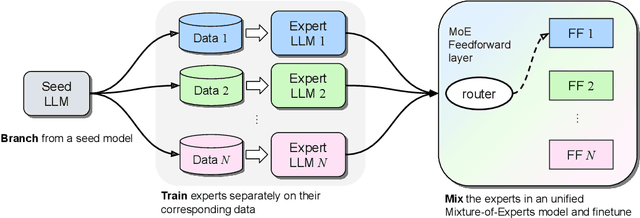

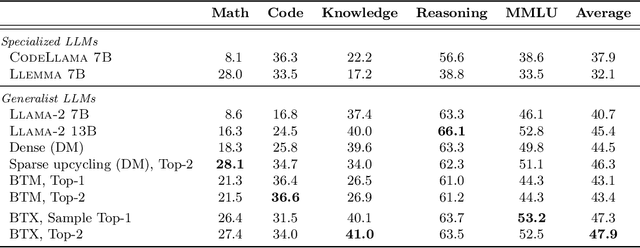
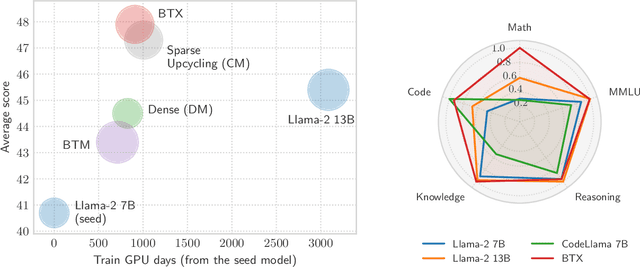
Abstract:We investigate efficient methods for training Large Language Models (LLMs) to possess capabilities in multiple specialized domains, such as coding, math reasoning and world knowledge. Our method, named Branch-Train-MiX (BTX), starts from a seed model, which is branched to train experts in embarrassingly parallel fashion with high throughput and reduced communication cost. After individual experts are asynchronously trained, BTX brings together their feedforward parameters as experts in Mixture-of-Expert (MoE) layers and averages the remaining parameters, followed by an MoE-finetuning stage to learn token-level routing. BTX generalizes two special cases, the Branch-Train-Merge method, which does not have the MoE finetuning stage to learn routing, and sparse upcycling, which omits the stage of training experts asynchronously. Compared to alternative approaches, BTX achieves the best accuracy-efficiency tradeoff.
Instruction-tuned Language Models are Better Knowledge Learners
Feb 20, 2024



Abstract:In order for large language model (LLM)-based assistants to effectively adapt to evolving information needs, it must be possible to update their factual knowledge through continued training on new data. The standard recipe for doing so involves continued pre-training on new documents followed by instruction-tuning on question-answer (QA) pairs. However, we find that LLMs trained with this recipe struggle to answer questions, even though the perplexity of documents is minimized. We found that QA pairs are generally straightforward, while documents are more complex, weaving many factual statements together in an intricate manner. Therefore, we hypothesize that it is beneficial to expose LLMs to QA pairs before continued pre-training on documents so that the process of encoding knowledge from complex documents takes into account how this knowledge is accessed through questions. Based on this, we propose pre-instruction-tuning (PIT), a method that instruction-tunes on questions prior to training on documents. This contrasts with standard instruction-tuning, which learns how to extract knowledge after training on documents. Extensive experiments and ablation studies demonstrate that PIT significantly enhances the ability of LLMs to absorb knowledge from new documents, outperforming standard instruction-tuning by 17.8%.
In-Context Pretraining: Language Modeling Beyond Document Boundaries
Oct 20, 2023Abstract:Large language models (LMs) are currently trained to predict tokens given document prefixes, enabling them to directly perform long-form generation and prompting-style tasks which can be reduced to document completion. Existing pretraining pipelines train LMs by concatenating random sets of short documents to create input contexts but the prior documents provide no signal for predicting the next document. We instead present In-Context Pretraining, a new approach where language models are pretrained on a sequence of related documents, thereby explicitly encouraging them to read and reason across document boundaries. We can do In-Context Pretraining by simply changing the document ordering so that each context contains related documents, and directly applying existing pretraining pipelines. However, this document sorting problem is challenging. There are billions of documents and we would like the sort to maximize contextual similarity for every document without repeating any data. To do this, we introduce approximate algorithms for finding related documents with efficient nearest neighbor search and constructing coherent input contexts with a graph traversal algorithm. Our experiments show In-Context Pretraining offers a simple and scalable approach to significantly enhance LMs'performance: we see notable improvements in tasks that require more complex contextual reasoning, including in-context learning (+8%), reading comprehension (+15%), faithfulness to previous contexts (+16%), long-context reasoning (+5%), and retrieval augmentation (+9%).
 Add to Chrome
Add to Chrome Add to Firefox
Add to Firefox Add to Edge
Add to Edge